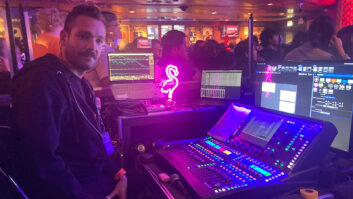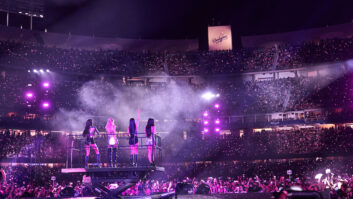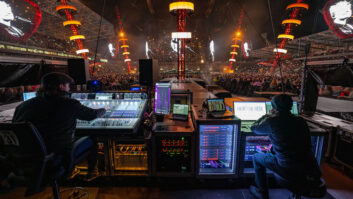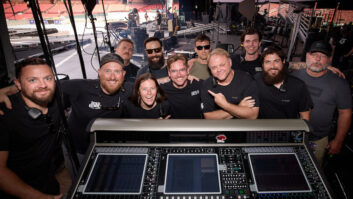
Ledisi concluded her 2014 The Truth tour in Sacramento, Calif., at the Red Lion Woodlake Hotel.
Photo: Steve Jennings
Singer/songwriter Ledisi started off 2014 with a bang by releasing her seventh album in March, The Truth (Verve), which she described as “a fiery version of Ledisi.” It features her dynamic, powerful vocals over vibrant, groove-driven songs, as well as ballads.
Ledisi launched The Truth tour in April with a seven-piece band comprising guitarist/musical director Chuck Gibson; backing vocalists Danetra Moore and Sara Williams; keyboardists Tony Walker and Mike Moore; bassist Idris Davis; and drummer James Agnew.
Over two months, the group visited 28 cities across the U.S. and Toronto, appearing before enthusiastic fans in theaters, halls and auditoriums. In late May, the tour touched down in San Francisco’s The Warfield Theatre, where she reconnected with her hometown fans, and Mix caught the high-energy performance.

Production manager and front-of-house engineer BJ Pendleton at the Yamaha CL5 console.
Photo: Steve Jennings
For this tour, Ledisi teamed up with Robert Glasper Experiment, a quartet led by pianist/keyboardist Glasper that fuses jazz, R&B and hip-hop in equal measure, with Glasper’s band opening.
Front-of-house engineer BJ Pendleton and monitor engineer Rick Wright, who have worked with Glasper, supported both bands. In addition, Pendleton assumed the role of production manager. “I always wear like five different hats, just because I’m that guy,” Pendleton says. This was both engineers’ first tour with Ledisi.
Show Systems of Orlando, Fla., provided most of the audio and backline gear for this tour; Pendleton opted to rely on house-provided P.A.—The Warfield has a Meyer Sound MILO system—and he also brought a selection of Neumann and Sennheiser microphones from his personal collection. “I was trying to learn their approach and integrate myself into it,” Pendleton says of his first outing with Ledisi. “I kept them all within their comfort zone, within the kind of gear that they were used to using.”
Ledisi and the backup vocalists each sing into Shure SM58 wireless capsules, which carried over from the previous tour, according to Pendleton. [To see a complete list of microphones, download a PDF of Ledisi’s input list for the 2014 “The Truth” tour.] “She can project,” Pendleton says of Ledisi. “She doesn’t hold back on me. She’s so powerful a singer that it makes my life easy.”

Monitor engineer Rick Wright at the Midas Pro2 console.
Photo: Steve Jennings
For FOH—mixing three to four vocalists, five rhythm-section instruments and six channels of Pro Tools playback—Pendleton selected a Yamaha CL5 digital console with a CL5 I/O Stage Rack and two Yamaha Rio3224-D I/O Racks. [For complete information, download Ledisi’s gear list for the 2014 “The Truth” tour.] “The preamps in that Rio Rack are really nice,” Pendleton notes. “We’ll pass [vocals] through the EQ, the compressor on the channel strip itself. But I try to keep things subtle as far as compression is concerned, even though she can really smash on a channel; she can get really loud at points.
“From there, I ended up routing her vocal through a couple pieces of the [CL 5’s] Premium Rack: the [Rupert Neve Portico 5043] compressor—it’s really smooth—and then a dynamic comp [the U76], as well. I ultimately routed her vocal through the dynamic compressor on the subgroup, just because she’s got a couple of frequencies in her voice around 2.15k that can be a bit much.
“Ledisi likes to feel the music,” adds Pendleton, who started out in music as a bassist in high school who set up P.A. systems and learned how to mix on the gigs. “I try to mix accordingly. Rhythm is the foundation of any style of music. I start with the drums and the bass—make sure that’s full, not too loud. And I like to keep things natural. I don’t use gates on the drums. I think they end up being unnatural, even with loud music. I like to let the drum set and all the microphones breathe together.”
Pendleton firmly believes that an FOH mix always ought to remain at a comfortable level for an audience, never becoming excessively loud and potentially fatiguing.
“Rather than boosting frequencies and turning things up too loud, [mixing is] all about removing certain frequencies,” Pendleton says, “spotting the resonant frequencies in the room that are just no good and pulling those out of the way to let the rest of the music be free to pass clearly. Let the room dictate how the mix needs to be that night.”
Monitor engineer Rick Wright works with a variety of entities, including production companies, live music venues, artists, bands and festival producers. “For me this was the first tour that I had been on that had proper rehearsal time,” Wright says. “I’m used to fly dates. We spent 10 days in Atlanta rehearsing with full band, dancers and our monitor rig. I was able to get the project pretty much dialed in at rehearsals and then tweak from room to room instead of building the project as the tour goes.”

According to monitor engineer Rick Wright: “The main rack carried the [Yamaha Rio3224-D I/O Racks] for the Yamaha CL5, the DL251 head-amps for the Midas Pro2, the Sennheiser G3 IEM systems, the Shure UR wireless handhelds, and a Midas AES50 to Dante converter. The idea behind this setup was to minimize interconnects each day. With a few Ethercon connections, two W4 mass connections, and a couple CPC connections you had most of the audio system completed each day. There is also a Gigabit Ethernet switch in the rear for tying all networkable items together under one network.”
Photo: Steve Jennings
Wright says that for The Truth tour, “I wanted to bring all of the monitors just to keep it a little more consistent; before, they were locally sourcing their monitors.” For monitors, Show Systems provided a Midas Pro2 digital console, Sennheiser G300 IEMs, L-Acoustics 115XT HiQ wedges and LA8 amps, and QSC KLA12 sidefills, KW181 sidefill subs, and a KW181 sub for Agnew’s drums. “Everybody onstage was on IEMs [a collection from Sensaphonics, Clear Tune Monitors, 1964 Ears, JH Audio, Shure and Sennheiser] except the dancers. The dancers leaned on the sidefills for reference. Ledisi and the singers had [two] wedges,” which served as backups to the IEMs.
Wright says that he selected the 64-channel Pro2, with 27 mix buses, specifically for this project. “The head-amps, EQs and compression are all top-notch with this desk. I actually utilized every mix bus and output and even had to use some direct-out patching for effects. I really love the population group approach that Midas utilizes. I programmed the desk in a fashion where I did not have to go looking for channels; instead I just brought the desired channels to me.”
Pendleton and Wright both cite the importance of creating a comfortable monitor mix for Ledisi. “She likes a hierarchy of herself, then drums, then [playback] tracks, then band and a small presence of the singers,” Wright explains. “She would ask for this ‘air’ to be there in her mix. This was a challenge of room mics and the various rooms every night. I would have to find that sweet spot where she felt like the ‘air’ was there, the crowd was not too loud, and things didn’t feel too distant. It was a tightrope feat sometimes, but I think after a few shows I was able to find that harmonious spot.”
Wright says that band members preferred to hear their particular instrument on top, followed by the playback tracks, drums and vocals. He adds that the sound crew’s wireless iPad management setup greatly facilitated communication with the performers.
“On this tour, from your iPad you could control the FOH Yamaha CL5 console, the Midas Pro2 monitor console, the Mackie [DL1608] iPad mixer [submixer for talkback mics] and our GoPro cameras,” Wright says. “This allowed BJ and me to be mobile around the stage and venue and still take requests. It allowed me to go out onstage during soundchecks and check in with players or singers while I am literally standing next to them.
“A side note on the talkback system: All the band members had switched SM58 talkback mics. They were submixed at the Mackie iPad mixer and then into the main split. This was a great way to communicate during shows when issues would arise. It also [provided] some comedic relief at times!”







